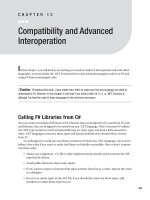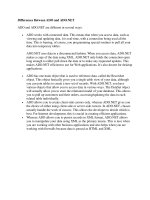Strength Modeling And Advanced Net Types Definitions
Bạn đang xem bản rút gọn của tài liệu. Xem và tải ngay bản đầy đủ của tài liệu tại đây (26.13 KB, 5 trang )
[ Team LiB ]
A.1 Strength Levels
Verilog allows signals to have logic values and strength values. Logic values are 0,
1, x, and z. Logic strength values are used to resolve combinations of multiple
signals and to represent behavior of actual hardware elements as accurately as
possible. Several logic strengths are available. Table A-1 shows the strength levels
for signals. Driving strengths are used for signal values that are driven on a net.
Storage strengths are used to model charge storage in trireg type nets, which are
discussed later in this appendix.
Table A-1. Strength Levels
Strength Level Abbreviation Degree Strength Type
supply1 Su1 strongest 1 driving
strong1 St1 driving
pull1 Pu1 driving
large1 La1 storage
weak1 We1 driving
medium1 Me1 storage
small1 Sm1 storage
highz1 HiZ1 weakest1 high impedance
highz HiZ0 weakest0 high impedance
small0 Sm0
storage
medium0 Me0 storage
weak0 We0 driving
large0 La0 storage
pull0 Pu0 driving
strong0 St0 driving
supply0 Su0 strongest0 driving
[ Team LiB ]
[ Team LiB ]
A.2 Signal Contention
Logic strength values can be used to resolve signal contention on nets that have
multiple drivers.There are many rules applicable to resolution of contention.
However, two cases of interest that are most commonly used are described below.
A.2.1 Multiple Signals with Same Value and Different Strength
If two signals with same known value and different strength drive the same net, the
signal with the higher strength wins.
In the example shown, supply strength is greater than pull. Hence, Su1 wins.
A.2.2 Multiple Signals with Opposite Value and Same Strength
When two signals with opposite value and same strength combine, the resulting
value is x.
[ Team LiB ]
[ Team LiB ]
A.3 Advanced Net Types
We discussed resolution of signal contention by using strength levels. There are
other methods to resolve contention without using strength levels. Verilog provides
advanced net declarations to model logic contention.
A.3.1 tri
The keywords wire and tri have identical syntax and function. However, separate
names are provided to indicate the purpose of the net. Keyword wire denotes nets
with single drivers, and tri is denotes nets that have multiple drivers. A
multiplexer, as defined below, uses the tri declaration.
module mux(out, a, b, control);
output out;
input a, b, control;
tri out;
wire a, b, control;
bufif0 b1(out, a, control); //drives a when control = 0; z otherwise
bufif1 b2(out, b, control); //drives b when control = 1; z otherwise
endmodule
The net is driven by b1 and b2 in a complementary manner. When b1 drives a, b2
is tristated; when b2 drives b, b1 is tristated. Thus, there is no logic contention. If
there is contention on a tri net, it is resolved by using strength levels. If there are
two signals of opposite values and same strength, the resulting value of the tri net
is x.
A.3.2 trireg
Keyword trireg is used to model nets having capacitance that stores values. The
default strength for trireg nets is medium. Nets of type trireg are in one of two
states:
•
Driven state— At least one driver drives a 0, 1, or x value on the net. The
value is continuously stored in the trireg net. It takes the strength of the
driver.
•
Capacitive state— All drivers on the net have high impedance (z) value. The
net holds the last driven value. The strength is small, medium, or large
(default is medium).
trireg (large) out;
wire a, control;
bufif1 (out, a, control); // net out gets value of a when control = 1;
//when control = 0, out retains last value of a
//instead of going to z. strength is large.
A.3.3 tri0 and tri1
Keywords tri0 and tri1 are used to model resistive pulldown and pullup devices. A
tri0 net has a value 0 if nothing is driving the net. Similarly, tri1 net has a value 1 i
f
nothing is driving the net. The default strength is pull.
tri0 out;
wire a, control;
bufif1 (out, a, control); //net out gets the value of a when control = 1;
//when control = 0, out gets the value 0 instead
//of z. If out were declared as tri1, the
//default value of out would be 1 instead of 0.
A.3.4 supply0 and supply1
Keyword supply1 is used to model a power supply. Keyword supply0 is used to
model ground. Nets declared as supply1 or supply0 have constant logic value and a
strength level supply (strongest strength level).
supply1 vcc; //all nets connected to vcc are connected to power supply
supply0 gnd; //all nets connected to gnd are connected to ground
A.3.5 wor, wand, trior, and triand
When there is logic contention, if we simply use a tri net, we will get an x. This
could be indicative of a design problem. However, sometimes the designer needs
to resolve the final logic value when there are multiple drivers on the net, without
using strength levels. Keywords wor, wand, trior, and triand are used to resolve
such conflicts. Net wand perform the and operation on multiple driver logic values.
If any value is 0, the value of the net wand is 0. Net wor performs the or operation
on multiple driver values. If any value is 1, the net wor is 1. Nets triand and trior
have the same syntax and function as the nets wor and wand. The example below
explains the function.
wand out1;
wor out2;
buf (out1, 1'b0);
buf (out1, 1'b1); //out1 is a wand net; gets the final value 1'b0
buf (out2, 1'b0);
buf (out2, 1'b1); //out2 is a wor net; gets the final value 1'b1
[ Team LiB ]









